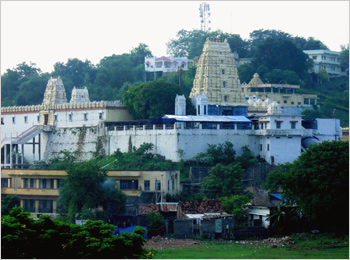- Vishnu
Bhadrachalam Sree Seetha Ramachandra swamy temple
- Bhadrachalam,Andhra Pradesh
- View on map
- Tell us about this temple
Overview
The Lord Sree Sita Ramachandra Swamy Temple in Bhadrachalam is situated in Bhadrachalam, Telangana. The temple is the site of grand celebrations on Rama Navami day, when the wedding anniversary of Lord Rama and his consort Sita takes place with much fanfare.
About the temple
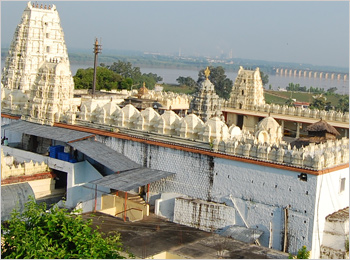
A sacred place that attracts lakhs of devotees from all over the world, it is the abode of Lord Rama (The seventh incarnation of Sri Mahavishnu). This hill place which is encircled by Holy River Godavari flowing towards southern direction is the famous shrine Bhadrachalam-The name derived from Bhadragiri (Mountain of Bhadra-a boon child of Meru and Menaka). According to an Ithihasas, the significance of this shrine dates back to the Ramayana Era. This coherent hill place existed in "Dandakaranya" Of Ramayana period where Rama with his consort Sita and brother Laxmana had spent their vanavasa- and Parnashaala (the place connected to the famous Golden Deer and the place from where Sita was abducted by Ravana.) is also in the vicinity of this temple site. It is at this Mandir site that, long after Ramavatara, Bhagawan Mahavishnu manifested Himself as Rama again to fulfil a promise He made to His Bhakta Bhadra, who continued his Tapas through Yugas, praying for the grace of the Bhagawan Sri Ramachandra murthy.
Exigency of Incarnation
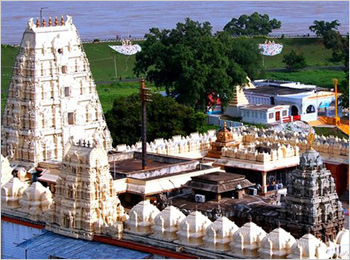
The history depicts that the need emerged the incarnation of Vykuntha Rama was that to fulfill a long desire of his ardent devotee Bhadra.
About the Deity
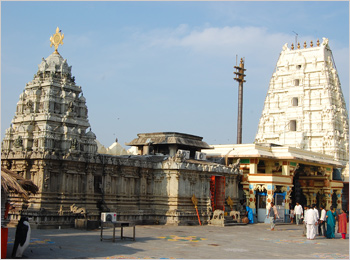
Lord Sree Sita Ramachandra Swamy Temple in Bhadrachalam is a Hindu temple of Lord Rama. The area is called as Bhadrachalam and is the venue of grand celebrations on Rama Navami day, when the wedding anniversary of Lord Rama and his consort Sita takes place with much fanfare. There are shrines for Lord Shiva and Lord Narasimha Swamy in this temple premises.
Legend and stories
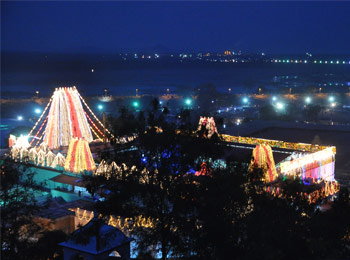
The temple in Bhadrachalam is closely connected with the life of the 17th-century saint composer Kancharla Gopanna who was known as Bhakta Ramadas. Gopanna was the Tahasildar of Bhadrachalam (second half of the 17th century), is said to have used money from the government treasury to build this temple, and was imprisoned in a dungeon at Golconda. Lord Rama is said to have miraculously given the Sultan the money spent by Gopanna, after which he was released. Gopanna then became Bhadrachala Ramadasa and went on to compose innumerable number of songs in Telugu in praise of Rama.
Bhadrachalam and Vijayanagara are sites said to have been closely associated with the Ramayana. Rama, Sita and Lakshmana are said to have stayed at Parnasala, 35 km away from Bhadrachalam. Rama is said to have crossed the river Godavari on his way to Sri Lanka to rescue Sita, at the spot where the Bhadrachalam temple stands, on the northern bank of the river. Legend has it that the son of Meru and Menaka, Bhadra, performed penances towards Rama here. Kabirdas, a Muslim by birth is also closely associated with this temple. It is believed that the images of the deities miraculously disappeared when Kabir was refused entry into the temple and that they reappeared miraculously upon his being permitted to enter.
Bhadrachalam attracts hundreds of thousands of devotees from all over the world. This hill place that is encircled by Holy River Godavari flowing towards southern direction is the famous shrine Bhadrachalam. The name is derived from Bhadragiri (Mountain of Bhadra: a boon child of Meru and Menaka). The history of this shrine stands for the significance of Ramayana Era; the coherent hill place existed in "Dandakaranya" of Ramayana period where Rama with his consort Sita and brother Lakshmana had spent their vanavasa. The vicinity of the temple had its incongruous mixture in another story which depicts the exigency of "Sri Mahavishnu" to manifest himself as Rama and shuffled again to the mortal coil — long after Ramavatara was to fulfill his promise to his Bhakta Bhadra (a mountain king), a sage who had been continuing the intense penance to get grace of Lord Rama.
Bhakta Ramadas and construction of temple
Kancharla Gopanna popularly known as Bhakta Ramadas constructed Bhadrachalarama temple. He was born to Linganna Murthy and Kamamba in Nelakondapalli village of Khammamett Taluk in the 17th century (1630 AD). As Tahasildar he was discharging his official duties earnestly and collecting revenues due to Nawabs in continuation of daily preaches: chanting of 'Ramanama' and the feeding the poor at his house. Ramadasa heard the news that the villagers of palvoncha paragana were proceeding to witness Jatara at Bhadrachalam. He, too, out of curiosity, visited Bhadrachalam. He found the deities in an amazing appearance; Ramadas then asked the villagers to contribute liberally for the construction of the temple. The villagers appealed to him to spend the revenue collections for the construction of the temple with a promise to repay the amount after harvesting the crops. As such Ramadas constructed the temple with Rs 6 Lakhs collected from the land revenues without the permission of the Golconda Nawab.
When the temple reached completion, he had a problem of fixing the 'Sudarshana Chakra' at the crest of the main temple. Deeply distressed he fell into sleep. On the same night, Rama in his dream asked him to have a holy dip in the river Godavari where he would find it accordingly. On the next day morning Gopanna did so and found holy Sudarshana Chakra in the river without much difficulty. He presumed that Sudarshana Chakra itself was shaped up with the divine power of his beloved God Rama. Soon after the construction, his miseries started. He was dismissed from service for misuse of revenue for constructing the temple, jailed for 12 years in Golconda Fort, and was tortured. Unable to withstand the miseries, Ramadas implored Rama to relieve him by singing many praising and emotional songs, which got popularized from the stanzas of 'Dasaradhi Sathakam' and 'Keertanas' of Bhakta Ramadasa.
The Golconda King Tanishah, the then ruler of Qutub Shahi Kingdom became a devotee of Rama who realized the devotion spirit of Ramadas after his imprisonment and took over the charge of temple administration. This resembles the communal harmony amongst the Hindus and Muslims.
The Golconda King, Tanishah realized Ramadas's devotional spirit and dedication towards Rama, when Rama and Laxmana repaid six lakhs mohurs exposing themselves as Ramoji and Laxmoji, the servants of Bhakta Ramadas to get release of their devotee from the imprisonment. Thanisha gave voucher to these divine looking persons who approached him at his house during late night. Then they kept the voucher under the pillow of Gopanna where he was jailed. Tanishah who woke up the next morning realized that those divine looking persons were none other than Rama and Laxmana and made arrangements to get release of Gopanna and prayed to forgive him by placing all the Gold Mohurs received last night at the feet of Gopanna. But, he refused to take back those mohurs except two as a mark of divine significance, and these two coins can still be seen in Bhadrachalam Temple.
Influenced by Lord Rama, Golconda Ruler Tanishah earmarked the income derived from the said Palwoncha paragana which came to Rs 20,000 and odd for the maintenance of the temple which was continued during Qutub Shahi's reign and offering pearls on the occasion of Kalyana mahotsavam (SriRamanavami) to Deities on an elephant through a specially sent messenger. That procedure of sending pearls to the Deities is still followed by present state Government and continued to offer during SriRamanavami Festival.
Tumu Narsimha Dasa, Tahasildar of Palwoncha paragana, with his associate Varada Ramadasa came here from Guntur and took over charge of Bhadrachalarama temple after Ramadas made inscribed the performance of Nitya Poojas and sevas right from early morning "Suprabhata Seva" till night "Pavalimpu Seva" before closure of the temple as "Silaasaasanaalu" on these two pillars. This inscription gave details of daily dittam and daily rituals also.
Festivals
Two major festivals are being celebrated every year which were introduced and traditionally celebrated right from the tenure of Bhakta Ramadas. "Vykuntha Ekadasi" a religious festival that attracts lakhs (hundred thousand) of devotees from all over the country at this famous shrine Bhadrachalam, is celebrated in the months of either December or January in 'Dhanur Masam' on the day of either Pushya or Margasira shuddha Ekadasi. The ten day festival called Adhyayanotsavams and Dasavatara Mahotsavams (10 incarnations) of Sri Maha Vishnu are preceded to Vykuntha Ekadasi Fete. On Dasami day, the colourful Teppotsavam is a special attraction to the devotees . The deities of Rama and his consort Sita will be taken into rounds on the holi river Godavari on a well decorated "Hamsavahana" ( on the swan shaped motor launch ) amid display of crackers and stupendous illumination . And on the auspicious Vykuntha Ekadasi day on the early hours exactly at 5 am Vykuntha dwarams at Northern Gate will be thrown open for darshan to devotees .The devotees believe that they will attain salvation after having Vykuntha Dwara darshan .This holi festival attracts lakhs of pilgrims. Vaaggeyakara Mahotsavams are being celebrated every year to commemorate Bhakta Ramadasa, a vaaggeyakara and an ardent devotee of Sri Rama. Dhyana Mandir, a prayer hall was constructed in 1972 in memory of Bhakta Ramadasa by Mr. Neelamaraju Venkata Sheshaiah, the then editor of Andhra Prabha by collecting funds from public through donations from Andhra Prabha (Telugu Daily News Paper) readers. Since then, the Vaggeyakaara mahotsavams are being celebrated during Mukkoti Ekadasi by inviting renowned musicians.
Sri Rama Navami Brahmotsavams.
Another major festival, Sri Rama Navami (the most popular one at Bhadrachalam) is being celebrated on every 'Chaitra shuddha navami ' on the auspicious 'Punarvasu' -'Janma Nakshatra' (birth star), of Lord Sri Rama. The Kalyanamahotsavam of Sri Rama with his consort Sita is celebrated on the holy occasion which falls either in the last week of March or first week of April. This divine festival is celebrated in a resplendent manner amid chanting of hyms by priests in Kalyanamantapam, richly engraved and exquisite sculptures depicting events from our Itihasas and Puranas, at the vicinity of stadium, where lakhs of devotees congregate to witness the fete with great devotional spirit and pay their owes for favours received or Solicited. The kalyanamahotsavam is celebrated on the holy occasion between 10 am and 12.30 pm and the sacred Talambralu showered on the deities exactly at 12 noon. This Sri Rama Navami Festival occassion is being broadcasted by All India Radio and telecast through Doordarshan on the festive day from 10 AM to 12 Noon. This is the only festival which is being covered by Akashavaani and Doordarshan as a Live programme all over the state (Andhra Pradesh).
Arti/Pooja/seva
The day begins at the temple with "Prabhadhotsavam" or awakening ceremony at 4.30 AM with specially composed songs of Tumu Narasimhadas, poems, Sannai Trupets Naubat etc. Abhishekam will be performed at 7.00 AM to Lord Rama on Sundays and all the remaining days abhishekams will be performed at Badruni Sannithi on the same time.
6.00 AM to 7.00 A.M Antaralaya Abhishekam (Mulavarulu on Sundays)
7.00 AM to 8.00 A.M Abhishekam (at Bhadra Temple) Daily
8.30 A.M to 8.00 P.M Kesavanaamaarchana
8.30 A.M to 9.30 A.M Sahasranamarchana
8.30 A.M to 9.30 A.M Suvarna Tulasi Astotharanamarchana (on every Saturday)
8.30 A.M to 9.30 A.M Suvarna Pushpa Astothara Namarchana (on Every Sunday)
8.30 AM Sakalbhishtaprada Sree Ramapuja (daily)
9.30 A.M to 11.00 A.M Nitya Kalyana Ubhayam (Daily, except during Pavitrotsavams,Brahmotsavams and Vykunta Ekadasi)
From 6.30 PM Rajata Ratha Seva
8.00 PM to 8.30 P.M Alaya Chuttu Seva
8.00 PM to 8.30 P.M Vahana Seva (Garuda, Hamsa, Hanumantha, Rajadhiraja)
Timing
4:30 am to 1:00 pm and 3:00 am to 8:30 pm.
Accommodation
In Bhadrachalam, excellent accommodation facilities are available - Government Guest Houses, Tourism Hotels, Cottages and Sadanams. Accommodation is also available in private hotels and lodges. Some of the Choultries and Sadans include:
TTD Choultry-Dhyana Mandir
TTD Choultry- Double Bed -Dhyana Mandir
Sri Rama Sadan
Yadagiri Sadan (Single)
Yadagiri Sadan (Double)
Tanisha Kalyana Mandapam
Tanisha Kalyana Mandapam
Sowmithri Sadanam
Sowmithri Sadanam (Upstairs)
Sri Rama Nilayam
Annavaram Choultry
Interesting facts
Parnashala is the most popular place around this famous Bhadradri Temple. According to Puranik tales, Rama stayed in this place during his 14-year exile in this dense Dandakaranya forests. During this time he made a make-shift thatched hut called Parnashala for their stay. It is at this spot Sita Devi spotted the Golden Deer. It is from this place Ravana abducted Sita Devi in the absence of Rama and Lakshmana. This beautiful Parnashala is 35 km away from Bhadrachalam. A small hut with gaudily painted sculptures of Sri Rama, Sita Devi, Lakshmana and Ravana depicting key events from Ramayan is what Parnasala is all about. One can also visit the wonderful “Pappi Hills” and “Perantalapalli”. Papikondalu Hills is another hilly place where one can enjoy the serene beauty.
Accessibility
Road
Government Buses and Private Travel buses from all places in Andhra Pradesh and Telangana are available to reach this Sree Seetha Ramachandra Swamy Temple in Bhadrachalam.
Rail
There is a Railway Station in Bhadrachalam Road, which is 40 km from the temple. This station is also referred to as Kothagudem Railway StationThe Railway stations in Hyderabad or Secunderabad. Or the bus stations in Hyderabad and Secunderabad from where the trains and buses are available to reach the temple in Bhadrachalam. If one is hiring a private taxi or a car from Hyderabad just follow this route: Hyderabad > Suryapet > Khammam > Kothagudem > Palvancha > Bhadrachalam.
Air
The nearest airport to the temple is Shamshabad, in the outskirts of Hyderabad. From here private taxis are available to reach.
Address
Bhadrachalam Temple,
Temple Road,
Near Bhadrachalam High Road,
Bhadrachalam
Khammam, Telangana (TS) - IN
Significance
Devotees visit this temple to seek fulfillment of the following:-
- Fame
- Freedom from diseases
- Wealth
- Courage
- Relief from adverse effects from bad planetary aspects
- Relief from bondage
Shlokas
Achutham Keyshavam Rama Narayanam Krishna Damodaram Vasudevam Harim Shridharam Madhavam Gopika Vallabham Janaki Nayakam Ramachandram Bhajey
Meaning -Oh Lord who cannot be perished, who also has names like Keshava, Rama, Damodara, Narayana, Sridhara, Madhava, Krishna, Ramachandra the beloved of Janaki, let me say your name regularly.
Vasudeva Sutham Devam Kamsa Chanoora Mardhanam Devaki Paramanandham Krishnam Vande Jagathgurum
Meaning -I bow to you O Krishna, the ultimate guru, Devaki and Vasudeva's son, and the destroyer of Kamsa and Chanur.
Adharam Madhuram Vadanam Madhuram Nayanam Madhuram Hasitam Madhuram Hridayam Madhuram Gamanam Madhuram Mathuraa Dhipate Rakhilam Madhuram
Meaning -Meaning - Sweet are Your lips, sweet is Your face, sweet are Your eyes, sweet is Your smile, sweet is Your heart, sweet is Your gait, O Lord of Mathura, everything about You is sweet.
Alokya Mathur Mukha Madarena Sthanyam Pibantham Saraseeruhaksham Sachinmayam Devam Anantha Roopam Balam Mukundam Manasa Smarami
Meaning -I think of this Balamukundan as the one who looks lovingly at his mother's face while taking milk from her, who has eyes similar to the red lotus, who is the embodiment of truth and intelligence and other forms.
Timings
04:30 a.m. to 11:00 a.m.06:30 p.m. to 08:30 p.m.
